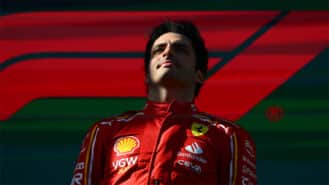
Only Tsunoda can save F1 in 2025: Japan GP – Going up, going down
In the face of soul-destroying boredom, only one driver can bring the entertainment needed to rescue a sport which resembles a broken AI tribute to itself
For the first time since it took a controlling interest in 1969, Fiat and Ferrari will effectively become different companies once more by this time next year. As part of his plan to fund an eye-watering £38 billion, five-year investment plan, Fiat Chrysler Automobiles (FCA) boss Sergio Marchionne will spin off Ferrari over the next 12 months, offering 10 per cent to the public and distributing the remainder of the company to existing FCA shareholders.
This way FCA gets to realise the value of its most prized asset while at the same time ensuring autonomy of operation for Ferrari at a time when some feared Marchionne’s arrival in Maranello would lead to Ferraris becoming little more than badge-engineered Fiats. It also neatly avoids being seen to be selling off an iconic Italian institution to foreign investors.

The news seems good and the market liked it, FCA’s share price in New York leaping 18 per cent on its receipt. For Ferrari it is a new dawn and the most significant change to its corporate structure since Fiat took over 45 years ago.
For the first time in years it will be responsible not to a board of management but shareholders, and this may or may not result in greater freedoms for Maranello to do as it chooses on both the road and racing car sides of its business. In theory it has achieved something close to independence from Fiat, in practice Ferrari has in fact operated effectively as an independent company within Fiat for years.
Of course for private investors the move now means there is a new Ferrari-branded accessory to add to the car in the garage, the jacket in the wardrobe and the watch on the wrist: a framed Ferrari share certificate will doubtless add even more glamour to even the most affluent of downstairs loos. And I am sure the arrangement will continue to thrive so long as Ferrari does too, especially if Marchionne succeeds in his stated ‘non-negotiable’ mission to return Ferrari to the top in Formula 1.

Perhaps of greater interest still is what this all means for the other brands that remain under FCA’s control. Marchionne’s five-year plan is brave particularly because now Ferrari is being hived off the remaining brands are not without their issues. Fiat, Chrysler, Jeep, Maserati and Alfa Romeo may all have known great times in the distant past but their more recent histories have been chequered to say the least and while Marchionne has impressively led FCA back to profitability, the company remains in debt and the job ahead – to turn FCA into a credible rival for the Volkswagen Group seems almost unimaginably vast.
To get there one thing is certain: Marchionne will need to instigate a product revolution. Marketing plays a part, and an important one too, but without the product to back it up it will only ever get you so far these days; thanks to the internet, the customer is far too well-informed to choose to put up with second, let alone third, fourth or fifth best. And the problem is that without Ferrari I cannot think of a single model from any of the aforementioned brands that is genuinely class-leading or, frankly, even close to it.
And the problem with product is that getting it right is expensive. Despite the terrifying strength of its existing portfolio (which includes Audi, Porsche, Bentley, Lamborghini, Bugatti, Skoda and Seat), this year VW will spend £10.9 billion on research and development alone. According to the Wall Street Journal, that’s £2.4 billion more than any other company on earth. By its own figures, for Marchionne’s strategy to work FCA revenues will have to better than double between now and the end of 2018 and sales increase from 4.4 million units at present to 7 million then.

Of course the bulk of the heavy lifting will be done by the American brands and Jeep in particular, but it leaves open the question of what will happen to Maserati and Alfa Romeo. The former is mid-transition and currently selling in numbers hitherto never contemplated thanks to the mainstream nature of the Ghibli saloon, though still small beer compared to its premium German rivals. The forthcoming Jeep-based Levante SUV should improve the picture further.
But Alfa Romeo? If I had a pound for every time Alfa’s been on the brink of something big, I’d be in the market for a new piggy bank by now. Its first step is to re-launch in the US with the 4C, a fabulous looking but profoundly flawed car, its next to produce a mid-sized saloon called Giulia to sell in the US, Europe and around the world. And that will be key: even the Americans might put up with a car’s limitations if it’s a recreation product, but Alfa badges alone will not be nearly enough for the Giulia. Indeed if it’s anything less than fully competitive with the best in the market – and I’m talking BMW 3-series, Mercedes C-class and potentially the Jaguar XE, it will likely struggle over here and sink without trace over there, taking a small but significant chunk of Signor Marchionne’s dream with it.

In the face of soul-destroying boredom, only one driver can bring the entertainment needed to rescue a sport which resembles a broken AI tribute to itself

Waking up at 4am on a Sunday is rarely worth it, especially when Max Verstappen looks poised to take another lights out to chequered flag victory — as he did…

Should there be a new prize for a team finishing sixth in the championship – just like the Jim Clark Trophy in the good old turbo times?

Sebastian Vettel is set to test a Porsche 963 Hypercar, having already been linked with a Le Mans drive. But would his return really add that much to the world of racing?